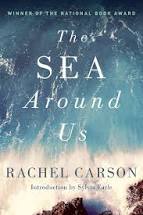The Sea Around Us
The book I read for the 2021 NONFICTION READER CHALLENGE in the category Oceanography is The Sea Around Us, by Rachel Carson, 1961 (with an updated bibliography and introduction in the 2018 edition).
I had to pick a book for this category, even though it’s not a subject that I would normally choose to read about. I’m more interested in aspects of the ocean where it meets land – islands and coastal areas, for example. The first book I ordered was The Boundless Sea by David Abulafia; the subtitle is ‘A Human History of the Oceans,’ and that seemed to combine my interests with the topic of oceanography. Unfortunately, that book (paperback version) is more than 1000 pages, and with the other activities that occupy my time, I didn’t think I’d be able to read this within a month. So, it’s still on my to-read list, but I then chose the book by Rachel Carson, which I had heard of as being ‘a classic.’ And it’s much shorter than 1000 pages.
I know a bit about Rachel Carson, but more in connection with her book, Silent Spring. So I thought this would give me an opportunity to become acquainted with her knowledge as a marine biologist and her writing, which has been described as ‘lyrical’ and even ‘poetic.’ And it is true that the writing is lovely, creating very vivid images beyond the scientific detail. An example of her description of the evolution of animal life in the sea and the creatures that eventually ventured onto land:
“When they went ashore the animals that took up a land life carried with them a part of the sea in their bodies, a heritage which they passed on to their children and which even today links each land animal with its origin in the ancient sea. Fish, amphibian, and reptile, warm-blooded bird and mammal – each of us carries in our veins a salty stream in which the elements sodium, potassium, and calcium are combined in almost the same proportions as in sea water.”
I particularly enjoyed the chapters on the birth of continents and on the description of the changes in the ocean throughout the seasons of the year. So many facts about the ocean were fascinating – for example, that waves have no effect on the ocean much deeper than the surface. However, the tides are more important than I realized – that they affect the whole ocean, “from its surface to its floor.” Carson writes:
“There is no drop of water in the ocean, not even in the deepest parts of the abyss, that does not know and respond to the mysterious forces that create the tide. No other force that affects the sea is so strong.”
What I enjoyed less were the sections with information that is obviously out of date. The chapters on the explorations of the ocean’s depths included phrases like “the recent discovery” (in the late 1950s) and “the discovery may be made any day” for something that might now be known.
The “Further Reading” section is also rather dated – there have been updates to this in the 1989 edition and in the edition I read from 2018, in which many of Carson’s suggestions are listed as out of print. Although the writing is very clear and readable, the dated information was rather disappointing to me. One of the things I like about reading non-fiction is the information I learn – if the writing is also done well, then I really enjoy the book. So this book was interesting, but not a complete pleasure to read.


Comments
Post a Comment